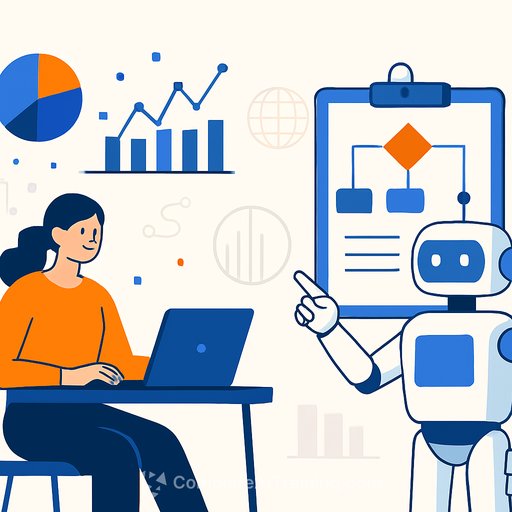AI for Smarter Development Evaluation Under Budget Pressure
Development co-operation budgets are tightening. The OECD projects a 9-17% drop in official development assistance (ODA) in 2025, after a 9% fall in 2024. By 2027, ODA could revert to 2020 levels. In this climate, every dollar must prove its value.
At the same time, needs are growing and data is piling up. Traditional evaluation methods struggle to deliver timely, actionable insight. AI offers a way to sift signal from noise at scale, so policy makers can focus on decisions that move outcomes.
How AI Can Strengthen Development Evaluation
Evaluators face fragmented reports, mixed data quality, and tight timelines. Large Language Models (LLMs) and related tools can speed up evidence work without sacrificing depth, as long as humans stay in the loop.
- Automate parts of systematic reviews: de-duplicate, classify, and map literature fast.
- Synthesize evidence across hundreds of evaluations to surface what works, where, for whom, and why.
- Spot emerging risks or success patterns across portfolios using unstructured text and metadata.
- Summarize long reports into decision-ready briefs with citations.
- Support cross-lingual search and translation to broaden the evidence base.
Recent collaboration backs this direction. The UK Foreign, Commonwealth and Development Office and Global Affairs Canada convened cross-sector experts in June 2025. The "Cape Town Consensus" focused on using AI to produce better and fairer evidence, with equity and ethics at the center.
Early Pilots to Watch
- Finland's Ministry for Foreign Affairs launched OpenEval, an AI-assisted hub for evaluative evidence.
- The UN Sustainable Development Group's System-Wide Evaluation Office built an AI tool to map and summarize evaluations.
- EvalNet, the OECD DAC Network on Development Evaluation, is documenting use cases to help others replicate what works.
What Must Be True for AI to Work
1. Interdisciplinary collaboration
Good tools don't appear by accident. Evaluators, data engineers, AI specialists, program teams, and end users need to build together from day one. Private sector partners can help meet quality and ethics standards, while governments set the rules and keep public priorities front and center.
2. Sensitivity to context
AI must reflect local realities. Many platforms are trained on biomedical and English-language sources, which can sideline research from the Global South and limit performance in non-Western languages. Written sources also miss oral evidence that carries indigenous knowledge.
Bring evaluators in early to encode these nuances. Engage neglected sectors and communities in tool design. This improves equity in the evidence ecosystem and supports locally led evaluations.
3. Trust, standards, and governance
Mistrust is still a major barrier. A 2024 EvalNet survey with the UK FCDO and Global Affairs Canada cites concerns about data safety and output quality. Shared standards, clear ethics, and strong governance are non-negotiable. The OECD Principles for Trustworthy AI are a useful anchor, and the NIST AI Risk Management Framework offers practical guidance for implementation.
See the NIST AI Risk Management Framework
Practical Moves for Policy Makers and Evaluation Leads
- Start with the decision, not the tool. Define the 3-5 priority questions you must answer this quarter.
- Stand up a minimal AI pipeline: document ingestion, de-duplication, tagging, retrieval, and traceable summarization.
- Use a bilingual or multilingual search layer to reduce English-language bias. Budget for translation and local review.
- Require citations and source links in every AI-assisted output. No citation, no use.
- Add basic safeguards: data access controls, PII scrubbing, and a model card or risk log for each use case.
- Pair every model with human oversight. Assign reviewers for methods, context, and stakeholder validation.
- Write procurement language now: transparency, reproducibility, audit trails, bias testing, and on-prem or VPC options for sensitive data.
- Measure value. Track time saved per review, coverage of Global South sources, and the hit rate of actionable insights that changed a decision.
- Build skills across roles. Train evaluators in prompt practices, retrieval, and verification; train engineers in evaluation logic and ethics.
If your team needs a structured path to upskill, explore role-based AI learning tracks here: AI courses by job
Bottom Line
Budgets are shrinking. Needs are rising. AI can help evaluation teams find the signal faster and focus effort where it counts, as long as judgment, context, and communities stay at the core.
Automation should complement critical thinking, not replace it. Use AI to serve established evaluative principles-relevance, effectiveness, and inclusion-and you'll make limited resources go further without sacrificing quality or fairness.
Your membership also unlocks:






